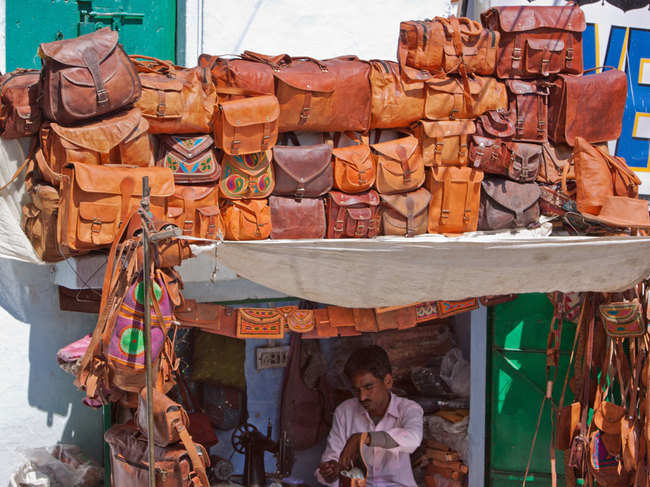 iStock
iStock
That, however, was the reality before the pandemic struck. With little or no liquidity, the industry now finds itself at the brink of total collapse.
“To survive through this extraordinary phase, the sector needs an instant shot of liquidity. 70% of our overseas orders have now been cancelled, and for the rest, buyers are asking for heavy discounts,” says Puran Dawar, Regional Chairman, North – Council for Leather Exports (CLE).
A cursory look across different leather-based industrial zones of the country gives further credence to the view that losses due to cancelled orders have only been mounting in recent times. In Agra, one of the globally famed, leather-based industrial hub, known to account for nearly 30% of the production of leather shoes in India, liquidity tops the list of bottlenecks faced by city’s leather goods manufacturers.
Revealing the drastic turn of events for leather exporters from this north India based cluster, Dawar, who is also the president of Agra Footwear Manufacturers and Exporters Chamber (AFMEC), adds that the regional cluster’s total exports reimbursement stuck (including for those goods undelivered at ports, ready but cancelled orders) stands at an upwards of about Rs 4000 crore. It’s noteworthy that India remains the second-largest producer of footwear in the world (according to Council for Leather Exports) and for many MSME-dominated industrial clusters such as the one at Agra, any lag in their working capital may prove suicidal for their very existence.
Also, in addition to direct exports, deemed exports, executed mainly by MSMEs in such clusters, also play an essential role in the entire supply chain, industry analysts agree. According to Dawar, in case of Agra footwear cluster alone, while direct exports of footwear is valued at around Rs 3500 crore, the ‘deemed exports’ of footwear is worth Rs 1500 crore.
Dawar further mentions that exports reimbursements relating to the spring-summer season have been stuck. While for the autumn-winter season, the cluster has raw materials, but already secured orders now either stand cancelled or have been put on hold indefinitely.
Eastern pain
The situation in the eastern part of the country, home to many leather-based hotspots, is equally grim.
“In the eastern region, handbags are a major commodity produced. This segment is severely hit as all the foreign retail outlets and buying houses are shut down. About Rs 2000 crore worth of orders have either been cancelled or have been put on hold,” discloses Ramesh Kumar Juneja, President Calcutta Leather Complex Tanners Association.
Making life further difficult for firms in the eastern part of the country these days is the devastating impact of Cyclone Amphan that has destroyed many firms’ critical infrastructure in many areas.
According to Juneja, shortage of workers is also hitting production. Completing an order is very difficult, since the industry doesn’t have a sufficient workforce to execute those.
 iStock
iStock"Now, even if we are getting a few orders, we are not able to run factories since most of the workers have gone back to their native places. The tragedy was that when the government had allowed factories to open with 35% workforce, we did not have more than 10% workforce,” he rues.
Asked if the government’s recent relief measures addressed their concerns, Juneja while ‘welcoming’ the announcements, states, “These are collateral-free loans that one has to repay, isn’t it so?”
Immediate help sought
Given the depressing state of affairs across various leather clusters, the industry believes the government should urgently offer liquidity support to the critical sector.
“Agra footwear sector is looking for support for at least one year salary and wages for which based on the turnover, a minimum of 10% Interest-free loan as term loan payable back in next 3 years, is being demanded. Also, 50% working capital support on the same is sought,” says Dawar.
To help the exporting fraternity in the leather sector, the industry representative pitches for lower interest rates. Mentioning that in countries such as Germany, interest rates for the leather sector stands at 0.25%, he asserts that due to the high cost of capital, the country loses competitiveness at global marketplaces.
“Today, even a reduced interest rate of 9.5% is not helping firms compete against global competitors. For the manufacturing sector, the interest rates should be based upon globally followed Libor rates. This, we want for the next 5 years. This is not a big ask as we are passing through unprecedented times that warrant unprecedented efforts.”
Dawar adds that the disbursement of wages and salaries for the next three months remains the sector’s biggest pain point today. To this effect, he suggests the living wages formula (which refers to the minimum income necessary for workers to meet basic needs) should be derived and paid from employees’ ESIC funds.
“ESIC is holding reserves of Rs 84,000 crore and this fund may be replenished by increasing contribution of ESI by 1% in the next 3 years. Interest-free term loan to the tune of 50% of present Cash credit (CC) limits payable yearly in the next 5 years should also be given to the sector,” he urges.











 Get Unlimited Access to The Economic Times
Get Unlimited Access to The Economic Times
